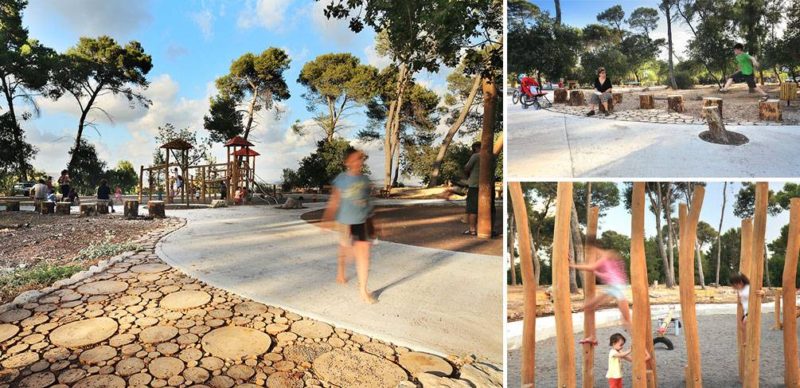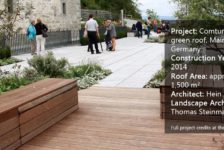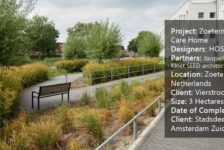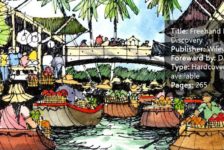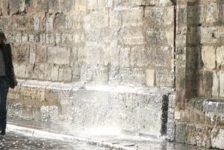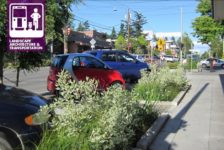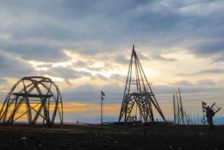Article by Joanna Łaska Hasomrim Park, by Bo Landscape Architecture, in Kiryat Tivon, Israel. Are the majority of today’s playgrounds really anything else but standardized? Colorful, but at the same time dull and monotonous. When you think about it, they all seem the same. Hasomrim Park by Bo Landscape Architecture is here to prove that designing with children in mind is totally a must if you want to succeed as a landscape architect. But what’s more, if we use not-so-obvious materials for a playground, we can turn this child-centered area into a broadly used park for everybody.
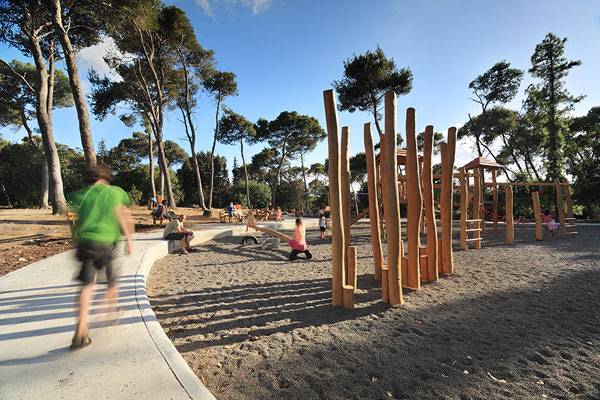
Hasomrim Park. Photo credit: Amit Haas
Designing for children is crucial in making urban spaces enjoyable for all. In fact, designs aimed strictly at children are often more effective in the final outcome than those designed for adults. Why? Because child-friendly spaces can be used by anybody, at any age. Let’s face it — everybody wants to let their inner child out from time to time. That’s exactly why adults can easily and gladly sit on the whimsical benches and bumps of a child’s playground, while a child is rather reluctant to interact with serious, adult-aimed designs. And if the child isn’t happy, neither is the parent. So why are there still so few spaces designed with children’s needs in mind?
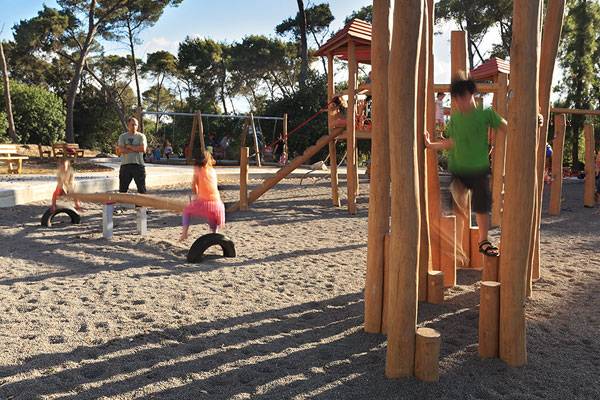
Hasomrim Park. Photo credit: Amit Haas
Today’s parents — and more importantly, today’s children — have grown sick and tired of prefabricated, “attested” playground zones, where you can do anything but have a good play. We have come to realize that meeting safety standards doesn’t always necessarily mean the best. Thankfully, Bo Landscape Architecture has thought outside the box and proved that playgrounds don’t have to be juvenile and colorful to encourage the creativity and imagination of children, and adults.
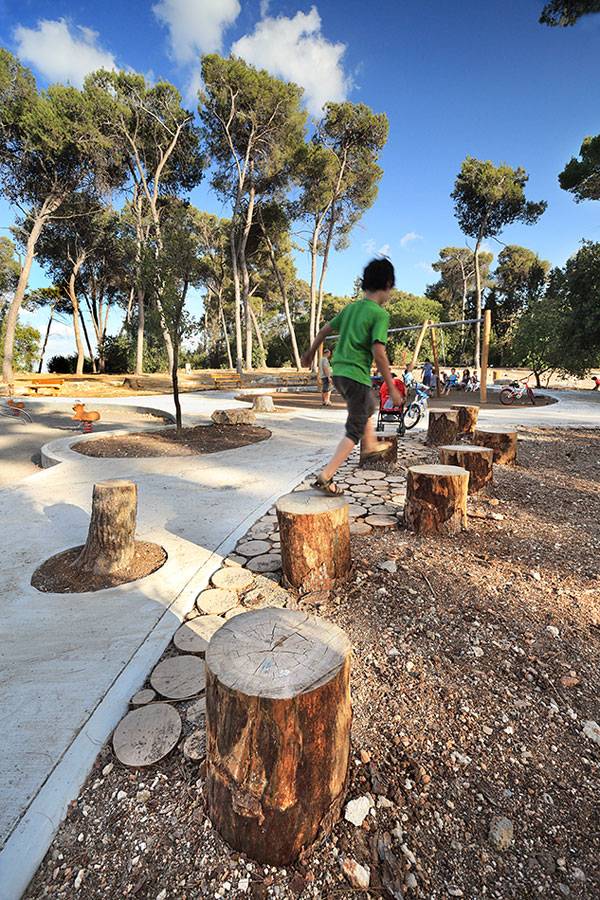
Hasomrim Park. Photo credit: Amit Haas
If you’re imagining another regular park with standard benches, ornate pathways, and fancy planting, Hasomrim Park is definitely not that kind of place. Surrounded by trees, the park is really an oversized playground that definitely meets the needs of users of all ages. Simple, yet amazingly effective plain walkways, only partly accompanied by wooden ornaments; sand-filled play spaces; and relaxation areas with remarkable elements awaken our imagination and create a place of universal harmony.

Hasomrim Park. Photo credit: Amit Haas
Swings, treehouses, benches, vertical poles, see-saws — whatever you like is all there. The twist: They can be used by both children and their parents in countless ways and they are made out of wood. Rows of wooden planks, for instance, can be used by children to walk and play on, while adults might use them to sit down and take a rest. If we think about it for a minute, we can simply realize that natural objects — such as tree trunks, sticks, leaves, and stones — are always one of a kind and unique, while prefabricated elements lack originality.
Ecological Factors at Play We adults can learn a lot from children. It’s no big secret that children can play at any place with any object. Children’s imagination can turn a simple floor into lava, so just think of the possibilities for play and games they can come up with given the space and prompts.
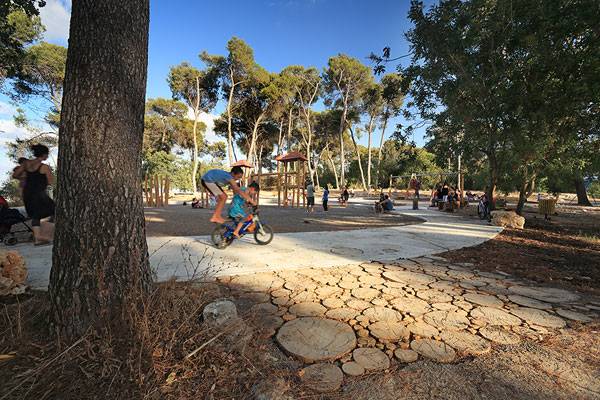
Hasomrim Park. Photo credit: Amit Haas
With this in mind, Bo Landscape Architecture came up with a solution to the modern plague of prefabricated playgrounds, giving children (and adults!) countless possibilities for play and relaxation. The children, their parents, and the environment are all happy in this equation. How? By making the playground in Hasomrim Park almost solely from natural elements. Wood and stone have replaced plastic and India rubber, ensuring that no ecological footprint is being left behind.

Hasomrim Park. Photo credit: Amit Haas
The natural elements in this park are not only a nice little change from the standard urban furniture we have so gotten used to; there’s also a deeper meaning to them. They definitely teach each and every one of us to respect nature more. Hasomrim Park definitely shows us that introducing natural, almost rural elements to urban areas doesn’t necessarily have to seem out of place. They can, as in this case, also turn out to be an absolute hit among potential users. So next time you design an urban area, think again about the materials. Try to go natural with the elements used, as they can really do wonders for your project, the potential users of the project and nature.
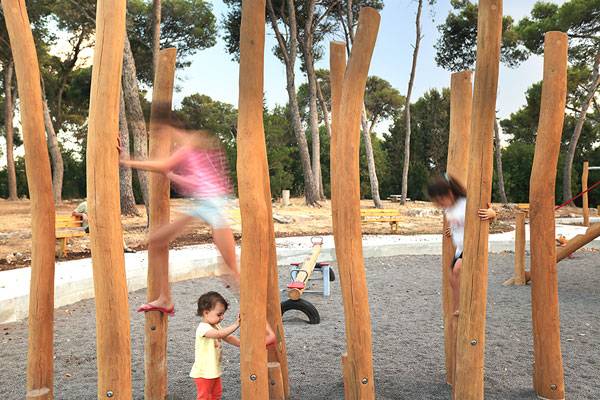
Hasomrim Park. Photo credit: Amit Haas
Full Project Credits For Hasomrim Park:
Landscape Architecture: Landscape Arch. Orna Ben-Zioni and Landscape Arch. Beeri Ben-Shalom are partners/owners of BO- Landscape Architects. Design Associate: Landscape Arch. Idit Israel Size: 13,000 sq”m Year of Completion: 2014 Client: Kiryat Tivon Local Council, Israel. Contractor: Sahr Khaldi. Photography: Amit Haas. Learn more about BO- Landscape Architects: Website: www.bo-landscape.co.il Facebook: www.facebook.com Recommended Reading:
Article by Joanna Łaska
Published in Blog









